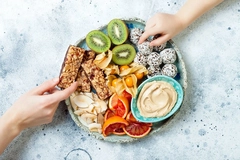Indulgence redefined: Cost, health and environment shape chocolate industry
17 Nov 2020 --- Some corners of the chocolate market are becoming more specialized as consumers seek sugar-free and dairy-free options. Conversely, cost-effective and comforting milk chocolate varieties are also seeing increased interest, revealing industry polarization. Experts from Barry Callebaut, Luker Chocolate and AAK speak to FoodIngredientsFirst about the category shifts in this space.
“Today’s markets are far more specialized and consumers more demanding. They are willing to pay more for healthy, natural products that are organic or ‘free from,’” observes Marcela Jaramillo Asmar, vice president of marketing at Luker Chocolate.
Bas Smit, global vice president of marketing at Barry Callebaut, has also seen a greater emphasis on health. He explains that members of Gen Z pursue a “symbiotic” life, considering themselves to be part of a greater ecosystem.

“They seek to live a happy, healthy life in balance with themselves and the world around them. Personal and environmental health has a different meaning for this generation. They expect and look out for artisans and brands who do more for society and the environment,” he details.
“Sugar intake, dairy-free, plant-based, organic, clean label are all topics to be addressed by the chocolate industry,” Smit continues. Barry Callebaut’s WholeFruit chocolate appeals to both sugar reduction and environmental demands.
Cutting out sugar
In light of health considerations, many consumers are moving away from chocolate sweetened with sugar, as has been standard.
Addressing this, Luker Chocolate recently launched sugar-free and natural sugar-alternative chocolate. These include allulose and erythritol-stevia sugar-free options or maple, coconut, agave and panela as sugar alternatives.
“Panela, in particular, is interesting as it is natural, unprocessed sugar, commonly produced by farmers in Colombia and for years has been included in chocolate. By including it in our chocolates, we can offer a product that is completely sourced in Colombia and offers a taste of our origin as well,” explains Jaramillo Asmar.
Meanwhile, Barry Callebaut’s WholeFruit chocolate is made from 100 percent cacao fruit. It has at least 40 percent less sugar, 90 percent more fiber and 25 percent more protein than most dark and milk chocolates.
However, Marco Oomen, global business director at AAK, observes regional differences in consumer health demands.
“In Asia and the Americas, chocolate confectionery can present itself as a permissibly indulgent treat by formulating with better-for-you ingredients, such as superfoods. In Europe, emphasizing the taste, local and ethical aspects of the chocolate, rather than the reduction in sugar and health, attract more attention,” he explains.
Plant-based becomes mainstream
Dairy-free and plant-based alternatives are another increasingly common demand. According to Innova Market Insights, there has been a 55 percent average annual growth in global chocolate, confectionery and ice cream launches with a plant-based claim (CAGR 2015-2019).
“Lifestyle choices play a big role, as seen in the growing demand for vegan-friendly options. This is driven by a more conscious consumer looking for better options for the planet and health. This consumer is also not willing to sacrifice taste, so it is important to find milk alternatives that deliver in both directions,” says Jaramillo Asmar.
Barry Callebaut is also active in this case, having recently introduced its dairy-free “M_lk chocolate.” It is part of Plant Craft, a wide range of dairy-free and vegan ingredients for chocolate, cocoa powders and nut products.Innova Market Insights reports a rising interest in plant-based claims in the chocolate space.
This also ties in with broader consumer awareness of environmental factors. “Increasing consumer awareness of the need to care for others and the environment means indulging treats should be good for the planet, too. Sustainability initiatives, zero-waste supply chains and upcycling are some ways to deliver on responsible and ethical treats,” says Smit.
A variety for every occasion
New varieties of chocolate are continually being unveiled, creating more choices than ever. Smit explains that final purchasing decisions tend to be driven by six different consumer needs:
- Recharging: Dark chocolate.
- Sharing or caring: Milk or white chocolate.
- Unwinding: Milk or white chocolate.
- Wholesome: WholeFruit chocolate.
- Pride: Dark chocolate.
- Hedonism: Ruby chocolate.
“Based on global consumer research in 2019 in 18 countries with 6,000 consumers, we found out that consumer demand differs depending on the occasion, time of the day, generations and need states, but taste is always the first criteria. We choose a chocolate to go along with that moment,” says Smit.
The battle between budget and high-end choices
Oomen also flags that cost is influencing purchasing decisions. “In the current situation, finances are one of the top important concerns among consumers and manufacturers. There is a growing trend toward reduced-cost solutions.”
In light of this, AAK has seen reduced demand for high-end specialty chocolate, such as single-origin dark chocolate. Instead, there is an increased demand for more basic types of milk chocolate.
Conversely, Luker Chocolate sees more growth in the premium segment, where consumers are willing to experiment with bolder flavors and place more value in craft alternatives and finer flavor profiles.
“This trend has been accelerated by private labels making premium chocolate more accessible to consumers,” explains Jaramillo Asmar.
Smit also expects so-called “masstige” products to grow in light of financial insecurity. These are accessible luxurious products, such as a chocolate praline box that can be found in supermarkets.
“Ultimately, both premium and mainstream varieties remain important. Consumers are faced with a choice between both ends of the spectrum: very premium products or good value for money. Consumers are ready to pay more for premium products if they deliver a better experience,” he states.
Texture contrasts dominate
Particularly in the premium sector, the overall sensory experience is a crucial element of chocolate.
“With fewer ingredients to compete with the pure chocolate taste, the consumer is now able to experience the unique attributes of each chocolate and even explore other ways to enjoy it, such as wine or coffee pairings,” says Jaramillo Asmar.
She adds that contrast in texture is also important, with many consumers interested in crunch provided by quinoa or cacao nibs.
Meanwhile, Barry Callebaut has developed a “texture language” for chocolate. Tests for flavor and texture are done individually, as it is difficult to focus on both elements.
“After the two tests are finalized, the R&D department can analyze the results and gather insights. Based on the conclusions, the team can experiment and come up with new solutions and innovations,” says Smit.
Meanwhile, AAK has developed trained panel procedures to create sensory profiles of chocolate. Sensory descriptors are typically presented in a spider web format and cover taste, as well as other sensory impressions such as hardness, brittleness, snap, melting speed and waxiness.
“Temperature also has an important role in this assessment and is kept the same throughout the test, particularly for the comparisons of the sensory profile of different products,” explains Oomen. Luker Chocolate expects to see increased availability and accessibility of differentiated premium chocolate alternatives.
The road ahead for chocolate
Looking to the future, Jaramillo Asmar anticipates that chocolate will become more prominent in categories beyond confectionery, such as healthy snacking, baking ingredients and hot beverages.
Oomen notes that the chocolate and confectionery category is generally benefiting from increased snacking. “However, considering the larger F&B universe is catering to this occasion, finding ways to differentiate and stand out from the competition is necessary.”
“We also anticipate more availability and accessibility of differentiated premium chocolate alternatives with opportunity for single-origin, differentiated flavors and ingredients, and functional claims,” adds Jaramillo Asmar.
Smit adds that consumers have always turned to chocolate as a way to indulge, and they will keep doing so.
“However, over the last few years, we have seen increasing consumer interest in bringing together both indulgence and health when they treat themselves. Consumer’s attitude change toward personal health and environmental health will define indulgence in the years to come,” he concludes.
By Katherine Durrell











